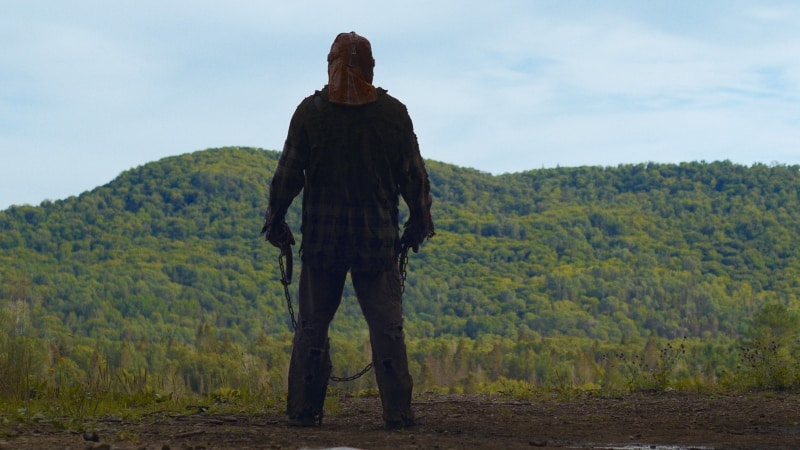‘In a Violent Nature’ Offers Deceptively Lackadaisical Thrills and Kills
Come for the shambling, highly motivated killer, stay for the year’s best cinematic kill.

A group of friends head into the woods for a fun vacation, but the good times soon turn to terror as a monstrous killer starts offing them one by one. Setups don’t come much simpler or more ubiquitous than that one, and the result is that most entries in the subgenre become immediately forgettable. There are standouts, though, that take the opportunity to one of two things. Some deliver a premise that’s a bit more unique than most like Cabin in the Woods (2011) or Tucker & Dale vs Evil (2010), while others take the opportunity to gift horror fans with unforgettable kills like the ones found in The Burning (1981) or Evil Dead II (1987). And sometimes? Sometimes we get a film like In a Violent Nature that manages to deliver both.
The camera hangs loosely in the air as we hear some people chatting about an abandoned structure in the forest, and as our eyes settle on a necklace draped across a pipe, one of the young trespassers reaches into frame and snatches it up. Viewers familiar with the horror genre will immediately give their heads a knowing shake — that fool just invited a metric ton of pain and suffering into their lives, and they don’t even know it. The thought has barely left the brain when another hand, this one weathered and meaty, bursts from the ground announcing the arrival of the film’s lead character. That’s right, the lumbering, undead hulk of a man we’ll come to learn is named Johnny (Ry Barrett) is the one we’ll be spending the bulk of the film with, and that time will be filled with walking, pondering, and some grim, grisly, and gory slaughtering.
Writer/director Chris Nash makes his feature debut with In a Violent Nature, and the film stands apart from the pack almost immediately. While occasional snippets of conversations between the young adults are overheard — sometimes as a barely audible aside, other times as if Johnny is listening nearby — Nash and cinematographer Pierce Derks‘ camera stays with Johnny. We’ve seen killer POV shots before in horror, but here we’re rarely more than just a few feet away as we orbit the killer’s travels between kills. The film’s story, such as it is, comes across as much through genre familiarity as it does the overheard conversations. A violent act years ago, a mysterious slaughter, the local legends that followed. We get the gist, and we’re gifted with the gristle.
It’s only January, but one of the kills executed so beautifully by In a Violent Nature feels like a shoo-in for the year’s best and most memorable. No spoilers here aside from it involving a head, a hook, and a hole. The film’s numerous other kills run the gamut from the more traditional to a pair of stellar decapitations, and they’re brought to life with a combination of practical effects and CG touchups/trickery that work well together to thrill and disgust in equal measure.
The kills would pop in any film, but here they sing as singular clashes against the film’s otherwise passive pacing and tone. Think Gus Van Sant’s Elephant (2003) for an idea as to Nash’s directorial style as we move about with a seemingly purposeless, casual feel. While there it was the daily motions of the doomed, here it’s the heavy-footed trudging of a dead man on a simple mission. The film’s square (or nearly square) aspect ration helps keep our focus in sync with Johnny’s, and the absence of a proper score means our ears are equally in tune with the dead man’s bloody “music.”
The approach taken by In a Violent Nature probably won’t fit the bill for most slasher fans, stellar kills aside, as it’s lacking the usual antics most common to the subgenre. There are no jiggly co-eds, obnoxious sidekicks, or potential heroes among the protagonist pool — hell, there really aren’t any protagonists at all. That’s part of the film’s unique charm, and it’s unfortunately also the area where Nash makes his only misstep. After sticking with Johnny throughout, the film’s finale makes a detour in honor of another slasher trope. The intent seems clear, but it’s a jarring, dialogue-heavy change that threatens to squander much of the atmosphere that came before.
Threatens, but doesn’t succeed, as that fumble can’t squash the atypical thrill of the eighty minutes that came before. Similarly, the minimalistic plot doesn’t prevent you from eagerly awaiting each new beat, each new step, and yes, each new kill. It’s a fresh approach to the endlessly familiar, and while you wouldn’t want to see it repeated necessarily, it makes for an entertaining walk in the woods.
